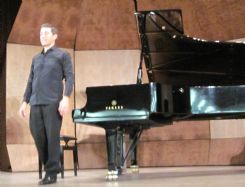|
Symphony
YOUTHFUL VIRTUOSITY ON DISPLAY AT USO'S MAY CONCERTS
by Peter Lert
Saturday, May 17, 2025
Symphony
MYSTICAL PLANETS AND LIVELY GERSHWIN ORTIZ AT FINAL SRS CONCERT
by Peter Lert
Sunday, May 4, 2025
Symphony
VSO'S CONCERT MUSIC OF TIME, MUSIC OF PLACE
by Peter Lert
Sunday, April 27, 2025
Choral and Vocal
VOCAL ELEGANCE AND FIRE AT THE 222'S RECITAL APRIL 26
by Pamela Hicks Gailey
Saturday, April 26, 2025
CANTIAMO SONOMA SINGS AN INSPIRED GOOD FRIDAY MOZART REQUIEM CONCERT
by Pamela Hicks Gailey
Friday, April 18, 2025
DRAMATIC SHOSTAKOVICH SYMPHONY CLOSES PHILHARMONIC'S 25TH SEASON
by Terry McNeill
Sunday, April 13, 2025
LARGE COLLEGE OF MARIN AUDIENCE GREETS STOPHER ARTISTRY
by Terry McNeill
Saturday, April 5, 2025
Chamber
FRISSON DELIVERS SHIVERS OF DELIGHT
by Abby Wasserman
Sunday, March 30, 2025
OLD AND MOSTLY NEW IN SRS MARCH CONCERT IN WEILL
by Peter Lert
Saturday, March 22, 2025
Symphony
TWO FORMIDABLE SYMPHONIES AND PURPLE MOUNTAINS AT SRS CONCERT
by Peter Lert
Sunday, February 23, 2025
|
 |
 Gustavo Romero On Berger's Stage Oct. 18 |
FORMIDABLE PIANISM FROM GUSTAVO ROMERO
by Terry McNeill
Thursday, October 18, 2012
Austin-based pianist Gustavo Romero has a second artistic home in Sonoma County, having played three times on the Oakmont Concert Series and in a number of private concerts. He returned to Oakmont’s Berger Auditorium Oct. 18 to play a formidable recital of Bach, Beethoven, Debussy and Rachmaninoff.
In one of the longest programs in recent memory, Mr. Romero played three Beethoven sonatas, finishing the first half with the mighty “Appassionata.” Throughout the afternoon, he was never in a hurry to get anywhere, even in the finale of the Appassionata, where performers tend to pile up too many notes in too short a space, thus blurring the musical line. Mr. Romero is neither a pianist of the most subtle phrasing nor a great colorist. What you hear is what you get--unfussy and well-thought out interpretations, left foot always on the shift pedal, no extraneous facial expressions or mannerisms, serious communion with the composer. It’s an approach sharply different from that of Lang Lang nearly three weeks previously in Weill Hall. Mr. Romero is all business.
He began with a lyrical performance of the Andante from Bach’s second violin sonata, in the Godowsky transcription. It was a balanced reading with deft inner lines and terraced dynamics.
In the first of the Beethoven sonatas, Op. 78, Mr. Romero continued his leisurely tempos, with differentiated repeats. It was graceful playing, as was the following, the popular “Hunt” sonata. This work requires the gentle touch Mr. Romero brought to it, the big sforzandos all the more surprising. He used a light pedal in the Scherzo, and though his scales were clear, they were hardly crystalline.
The Appassionata, played often in Santa Rosa in the past five years, was a relaxed but thankfully a nonstructural interpretation. This sonata is emotional throughout, including the short set of variations making up the middle movement, which uses one of Beethoven’s most attractive melodies. Mr. Romero varies his trills from moderate to brilliant all through the piece, and twice he let the sound linger with long movement-ending fermatas. The finale, marked Presto, was hardly that but showed clear articulation, and the dynamic sweep was always under control. A careful but effective interpretation.
Tonal color was foremost in the three Debussy works that opened the second half. “Pagodes” was played atmospherically, with the pianist using half-pedal effects, creating a wash of soft and bell-like sounds. “La Soirée dans Grenade” has a habanera rhythm that Mr. Romero emphasized, almost to the detriment of the guitar effects. The last piece, “Jardins sous la pluie,” was played with a broad dynamic range, and the multiple dynamic levels were carefully rendered. Here the artist’s tempo was faster and the result was a highlight of the recital.
Rachmaninoff preludes, preceded by the early Op. 3 “Elegie,” closed the recital. The lush Chopineque melodies of the Elegie were languorously and elegantly played, leading to five preludes, each of a sharply different character. The B Minor of Op. 32, reported by Moiseiwitsch to be the composer’s favorite, was played with rich colors and a masterful control of pianissimo. A series of sleigh-bell sounds came with the Op. 32 prelude in G-Sharp Minor, the vocal nature of the writing beautifully underscored by the pianist. Two preludes in G followed. The Op. 23 version had the right “military” character with bright repeated right-hand chords, and the Op. 32 waxed nostalgic. In the latter, Mr. Romero played the final three chords chastely, with just the right silence between them.
The concluding prelude was the glorious one in D Flat Major, played here more slowly than usual. It had a monumental and powerful sound, and the chordal voicing was always even.
Repeating an encore of a past Oakmont recital, Mr. Romero played Turkish composer Fazil Say’s “Black Earth,” a 1997 work that makes use of held forte pianistic chords combined with hand-muted (on the strings) notes and quick right-hand figurations. It was a long encore but beguiling and well received.
|

